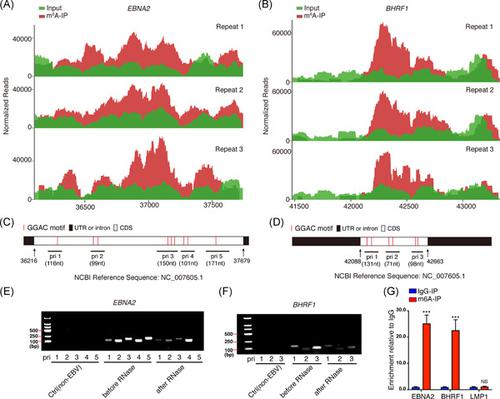当前位置:
X-MOL 学术
›
Immun. Inflamm. Dis.
›
论文详情
Our official English website, www.x-mol.net, welcomes your feedback! (Note: you will need to create a separate account there.)
RNA m6A methylation regulates virus–host interaction and EBNA2 expression during Epstein–Barr virus infection
Immunity, Inflammation and Disease ( IF 2.493 ) Pub Date : 2021-01-12 , DOI: 10.1002/iid3.396 Xiang Zheng 1, 2, 3, 4 , Jia Wang 1, 2, 4, 5 , Xiaoyue Zhang 2, 4 , Yuxin Fu 2 , Qiu Peng 2, 4 , Jianhong Lu 2 , Lingyu Wei 2, 4 , Zhengshuo Li 2, 4 , Can Liu 2, 4 , Yangge Wu 3, 4 , Qun Yan 6 , Jian Ma 1, 2, 4
Immunity, Inflammation and Disease ( IF 2.493 ) Pub Date : 2021-01-12 , DOI: 10.1002/iid3.396 Xiang Zheng 1, 2, 3, 4 , Jia Wang 1, 2, 4, 5 , Xiaoyue Zhang 2, 4 , Yuxin Fu 2 , Qiu Peng 2, 4 , Jianhong Lu 2 , Lingyu Wei 2, 4 , Zhengshuo Li 2, 4 , Can Liu 2, 4 , Yangge Wu 3, 4 , Qun Yan 6 , Jian Ma 1, 2, 4
Affiliation

|
N6‐methyladenosine (m6A) is the most prevalent modification that occurs in messenger RNA (mRNA), affecting mRNA splicing, translation, and stability. This modification is reversible, and its related biological functions are mediated by “writers,” “erasers,” and “readers.” The field of viral epitranscriptomics and the role of m6A modification in virus–host interaction have attracted much attention recently. When Epstein–Barr virus (EBV) infects a human B lymphocyte, it goes through three phases: the pre‐latent phase, latent phase, and lytic phase. Little is known about the viral and cellular m6A epitranscriptomes in EBV infection, especially in the pre‐latent phase during de novo infection.
中文翻译:

RNA m6A甲基化在爱泼斯坦-巴尔病毒感染期间调节病毒-宿主相互作用和EBNA2表达
N 6甲基腺苷 (m 6 A) 是信使 RNA (mRNA) 中最普遍的修饰,影响 mRNA 的剪接、翻译和稳定性。这种修饰是可逆的,其相关的生物学功能由“作家”、“橡皮擦”和“读者”介导。病毒表观转录组学领域和 m 6 A 修饰在病毒-宿主相互作用中的作用最近引起了广泛关注。当爱泼斯坦-巴尔病毒 (EBV) 感染人类 B 淋巴细胞时,它会经历三个阶段:潜伏期、潜伏期和溶解期。关于EBV 感染中的病毒和细胞 m 6 A 表观转录组知之甚少,尤其是在从头感染的前潜伏期。
更新日期:2021-01-12
中文翻译:

RNA m6A甲基化在爱泼斯坦-巴尔病毒感染期间调节病毒-宿主相互作用和EBNA2表达
N 6甲基腺苷 (m 6 A) 是信使 RNA (mRNA) 中最普遍的修饰,影响 mRNA 的剪接、翻译和稳定性。这种修饰是可逆的,其相关的生物学功能由“作家”、“橡皮擦”和“读者”介导。病毒表观转录组学领域和 m 6 A 修饰在病毒-宿主相互作用中的作用最近引起了广泛关注。当爱泼斯坦-巴尔病毒 (EBV) 感染人类 B 淋巴细胞时,它会经历三个阶段:潜伏期、潜伏期和溶解期。关于EBV 感染中的病毒和细胞 m 6 A 表观转录组知之甚少,尤其是在从头感染的前潜伏期。



























 京公网安备 11010802027423号
京公网安备 11010802027423号